Dominique Luchart's Blog, page 571
July 10, 2021
Tesla finally begins shipping ‘Full Self-Driving’ beta version 9 after a long delay, Andrew J. Hawkins
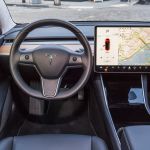
Tesla began sending out over-the-air software updates for its long-awaited “Full Self-Driving” beta version 9, the definitely-not-autonomous-but-certainly-advanced driver assist system.
As promised by Elon Musk, the software update (2021.4.18.12) began uploading after midnight on Friday, giving thousands of Tesla owners who have purchased the FSD option access to the feature, which enables drivers to use many of Autopilot’s advanced driver-assist features on local, non-highway streets.
[embedded content]Musk has been promising v9 of the software for, well, a while now. He said in 2018 that the “long awaited” version of FSD would begin rolling out in August. He did it again in 2019, proclaiming that “a year from now” there would be “over a million cars with full self-driving, software, everything.” Earlier this month, he claimed that “FSD 9 beta is shipping soon.” So to say that Tesla fans have been anticipating this update for a while would be an understatement.
New Visualizations. #fsdbeta pic.twitter.com/DamYuSmlNf
— Eli Burton (@EliBurton_)
The real question is whether it’s ready for primetime. To that, Musk gave a typical muddled response, tweeting that “Beta 9 addresses most known issues, but there will be unknown issues, so please be paranoid.” He added, “Safety is always top priority at Tesla.” Release notes included with the update warn testers that “it may do the wrong thing at the worst time” and to avoid complacence. They also mention improvements to the cabin camera’s driver monitoring to check for attentiveness, along with updated, larger visualizations on the in-car display (as shown above).
Running preproduction software is both work & fun. Beta list was in stasis, as we had many known issues to fix.
Beta 9 addresses most known issues, but there will be unknown issues, so please be paranoid.
Safety is always top priority at Tesla.
— Elon Musk (@elonmusk)
There’s no question that Tesla is more willing than its competitors to test beta versions of its Autopilot driver assist feature on its customers in the interest of gathering data and working out any bugs in the system. And Tesla customers are mostly fine with this, routinely flooding Musk’s mentions begging to be admitted into the company’s Early Access Program for beta testers. This has helped contribute to Tesla’s public reputation as a leader in autonomous driving, despite its vehicles continuously falling short of what most experts would agree defines a self-driving car.
Tesla warns that drivers need to keep their eyes on the road and hands on the wheel at all times, though the automaker famously refuses to include a more robust driver-monitoring system (like infrared eye tracking, for example) to ensure its customers are following safety protocols (although maybe that’s changing). Autopilot is considered a Level 2 “partially automated” system by the Society of Automotive Engineers’ standards (and by Tesla’s lawyers), which requires that drivers keep their hands on the wheel and eyes on the road.
However, consumer advocates have proven that Tesla’s system can easily be tricked into thinking there’s someone in the driver seat, which gained renewed attention in the aftermath of a fatal crash in Texas involving a Tesla, in which authorities said there was no one behind the steering wheel.
But this hasn’t stopped some Tesla owners from abusing Autopilot — sometimes going so far as to film and publicize the results. Drivers have been caught sleeping in the passenger seat or backseat of their Teslas while the vehicle speeds down a crowded highway. A Canadian man was charged with reckless driving last year after being pulled over for sleeping while traveling at speeds of 93mph.
Since Tesla introduced Autopilot in 2015, there have been at least 11 deaths in nine crashes in the US that involved the driver assistance system. Internationally, there have been at least another nine deaths in seven additional crashes.
Meanwhile, the US government is requiring that car companies report crashes involving autonomous vehicles or advanced driver assist systems, often within a day of the incident. It was a major change that signals a tougher stance on these partially automated systems by regulators.
The post Tesla finally begins shipping ‘Full Self-Driving’ beta version 9 after a long delay, Andrew J. Hawkins appeared first on NEWDAWN Blog.
The search is over: smart trackers from Apple, Samsung, and Tile compared, Allison Johnson
 Bluetooth trackers are poised to hit the mainstream with new options from Apple and Samsung.
Bluetooth trackers are poised to hit the mainstream with new options from Apple and Samsung.This year will go down in history as the year we entered the golden age of Not Losing Your Stuff. Well, in addition to some other historic milestones, somewhere in the top 100 hits of the year will be the introduction of smart tracker tags from two major mobile device manufacturers: Samsung and Apple.
Tracking tags have been around for a while now, and Tile has been the best-known brand in the space. With new options from the two most popular US phone manufacturers entering the picture, tracking tags may be poised to go mainstream. If you’re thinking of picking one up but unsure where to start, then you’re in the right place. We tried out three top tracking tags — the Samsung SmartTag Plus, Apple AirTag, and Tile Pro — to see how they compare.
First, a word about the very real privacy concerns about these tracking devices. Since their introduction, critics have noted that they could all too easily be used as tools for stalkers, since they’re easy to hide in someone’s bag or car. These concerns were amplified when Apple’s AirTags arrived, given how ubiquitous Apple’s Find My network is. Apple built in certain anti-stalking safety measures at launch, but reporters quickly identified ways that these safeguards fell short.
The company has addressed some issues, like shortening the length of time before an AirTag will sound an alert when it’s separated from its owner, and is working on an app that will allow Android users to find unwanted AirTags near them. But some potential for misuse will remain even with more safety measures in place.
Apple (justifiably) attracts more scrutiny for its safety practices given the size and effectiveness of its tracking network, but it’s hardly alone in its somewhat reactive attitude toward stalking concerns. Samsung introduced a SmartThings app feature that scans for unfamiliar SmartTags, and Tile says it’s working on a similar feature. It doesn’t help that these devices more or less live inside their own manufacturer’s walled garden — a unified, cross-platform approach is sorely needed. Anyway, it’s illegal (and highly immoral) to track someone without their knowledge, so don’t do it.
Per usual, adding new tech to your life involves more terms and conditions to agree to. However, in this case you may have already accepted them when you set up your Apple or Samsung phone. Tile’s app, which you must download to use the Pro, presents its own separate set of terms of service.
 Tile has been the best-known brand in the tracking tag space until now.
Tile has been the best-known brand in the tracking tag space until now.Personal trackers are nothing new — GPS and cellular options have been around for quite some time, and offer more precise, real-time location tracking. They also tend to come with a higher price tag, recurring subscription or wireless data fees, and require more battery power. This newer class of Bluetooth trackers are more practical for most people, with battery life measured in months rather than days and smaller, keyring-friendly form factors.
Essentially, the three tags compared here all do the same thing. Pair it to your phone, attach it to something you want to keep track of, and you’re ready to go. When the tracker is within Bluetooth range of your phone, you can have the tag play a sound to help locate it. All three devices support out-of-range finding with their own particular device user networks, and they all include the same kind of user-replaceable CR2032 coin cell battery.
Their main difference is whether or not they include AR-assisted finding by way of Ultra Wideband (UWB) connectivity: the Samsung and Apple tags have this and the Tile Pro does not. To take advantage of the AR feature, you’ll need a phone with UWB; on the Apple side that’s an iPhone 11 or newer, and for Samsung it’s a Galaxy Note 20 Ultra, Z Fold 2, S21 Plus, or S21 Ultra. There are also compatibility differences: Apple’s tracker only works with iOS devices and Samsung’s only works with Galaxy devices (no, you can’t register it through the SmartThings iOS app, I tried), whereas Tile works on both iOS and Android.
 Apple’s AirTag is the least expensive of the bunch, but without a built-in keyring hole you may need to buy a holder.Apple AirTag
Apple’s AirTag is the least expensive of the bunch, but without a built-in keyring hole you may need to buy a holder.Apple AirTagThe AirTag comes in just one flavor: a small, $29 disc shape. It’s the only one of the three to include an official IP67 rating, meaning it can survive a dunk in a bit of water. It also allows you to store your contact information so it can be read by any phone with NFC (near-field communication) — even Android phones. Setup is dead simple — just bring the tag near your iPhone and you’ll be prompted to pair the two. It’s also a little less expensive than the other two, but there’s no hole built in, so if you want to attach it to a set of keys you’ll need to pay a little more to add a holder. (We don’t really recommend drilling a hole into it, though iFixit has a guide if you insist.)
When it’s outside the Bluetooth range of your phone, the AirTag taps into the massive network of iPhone devices using Find My to provide an approximate location. This is a huge benefit, especially in the US where iPhones abound. As long as your item is in a place with people, it will likely be “seen” by an iPhone nearby.
In-range, AR-assisted finding does a good job of tracking down an object that’s out of sight. A big, easy-to-follow arrow appears on screen when the signal is strong enough (you’ll be prompted with a vague message to move around if you’re too far for a strong signal) and guides you in the right direction. I had no problem locating a tag under a couch cushion in my house. It would be helpful if the “weak signal” message indicated if the signal got stronger as you move around (Samsung’s AR finding does this) but that’s my only complaint.
If you’d like to altogether avoid the headache of leaving something behind, Apple is adding a separation alert feature in iOS 15 that may help. Once set up, it will send a notification if it detects that your iPhone (and by extension, you) have gone out of range and left it behind. Tile also offers this feature with its Premium subscription.
 SmartTag Plus includes AR-assisted finding for objects in close range.Samsung SmartTag Plus
SmartTag Plus includes AR-assisted finding for objects in close range.Samsung SmartTag PlusThe $39 SmartTag Plus is Samsung’s UWB-equipped tag; there’s also a non-UWB version for $10 less. The SmartTag Plus offers broadly similar Bluetooth-range finding and AR-assist as the AirTag, with a few differences. AR finding mode provides a view through the phone’s camera with guiding arrows that appear on the screen, which is a little more helpful than Apple’s arrow-only guide.
You can also use the button on a SmartTag as a kind of remote starter for smart home automations if you’re invested in Samsung’s SmartThings ecosystem. On the downside, the SmartTag has the shortest battery life rating of the three trackers compared here: up to 165 days (less than six months) compared to about a year for the Tile and Apple options. SmartTags don’t offer separation alerts at the moment either.
Out-of-range, the SmartTag Plus relies on other Galaxy devices that have chosen to participate in Samsung’s Galaxy Find network — Galaxy phone users aren’t opted in by default, and need to give consent in the SmartThings app. Samsung says that as of April 2021, there were more than 70 million “helper devices” participating globally; Apple counts hundreds of millions of users in its Find My network. There are simply fewer people in the US with Galaxy phones than iPhones, so it can’t quite compete with the AirTag, but that’s a moot point anyway since nobody is likely to be comparison shopping between the two.
Experiences will vary — more so than with an AirTag — but at least in the northern suburbs of Seattle, there were enough Galaxy Find users out and about to track a tag on a cross-town journey with multiple stops. Knowing the actual location of the object, er, spouse who agreed to let me track him, the SmartTag did identify his position accurately at two of three stops. It only returned a location a couple of times when he was on the interstate getting to his destination, but in a fairly busy business park and at a restaurant, the SmartTag gave me an accurate enough location that I could have driven up I-5 myself and located the tag.
 Tile’s tags work with both iOS and Android devices.Tile Pro
Tile’s tags work with both iOS and Android devices.Tile ProTile has been the tracking tag category heavyweight of the last few years — at least until Samsung and Apple showed up. The Pro is the company’s highest-specced model at $34, with a bigger Bluetooth range (400 feet) and a louder maximum ring volume than other current Tile tags. There’s no Ultra Wideband here, and thus no AR-assisted finding.
Separation alerts are available as part of Tile’s $29/year Premium subscription, but all of the essential features are included with your Tile tag purchase, including out-of-range finding. This “community find” feature relies on other Tile users — and as of June 14th, Amazon’s Sidewalk network — the way Samsung and Apple’s trackers rely on other Galaxy phones and iPhones.
Even with help from Sidewalk, the Tile Pro’s peer-location network seems to lag behind Samsung and Apple’s. On the same journey up I-5 that the SmartTag Plus took, the Tile Pro returned a location ping less frequently, and only got one of the stops on the trip precisely right (it was close but across the street on another one) where the SmartTag was accurate on two locations.
This was honestly a better performance than I was expecting, though Seattle probably has more than its usual share of Sidewalk-supporting Amazon devices for obvious reasons. Even if it’s an atypical result, it’s fair to say that the community find feature would work well enough to tell you that you really did lose something, even if it’s less likely that you’ll be able to hunt down its exact location.
I do have one minor complaint to lodge against the Tile app: the subscription upsell. A couple of app menus include features that are only available with the Premium plan, and tapping them brings up a page prompting you to start a free trial to access them. I expect to see those kinds of things during setup, or if I’m using a free app like Strava, but it’s a little annoying from something I’ve already paid for.
Tile also offers its trackers in a couple of different form factors, including a wallet-friendly Slim version and a small adhesive-backed Sticker tag. There are plenty of third-party cases and holders for AirTags in particular if you want to adapt it for different objects, but you can’t buy an AirTag or a SmartTag in a fundamentally different shape.
AirTag or Tile Pro?If you have an iPhone, there’s a very simple answer to this question: just get the AirTag. The Apple Find My network is so extensive (at least in the US) that you’ll have the best chance of tracking down something the tag is attached to. Maybe there’s an exception to this recommendation if you really want Tile’s subscription features or mix of form factors, but by and large this is a no-brainer.
SmartTag Plus or Tile Pro?If you have a Samsung phone you’ll probably be better off with the SmartTag Plus. The Galaxy Find network isn’t as robust as Apple’s, but it’s still ahead of Tile’s. If you already use smart home devices in Samsung’s SmartThings network, then there’s even more reason to choose SmartTag since it can act as a remote control for automations. The shorter battery life is a shame and the lack of separation notifications stinks, so if those are sticking points you could consider the Tile Pro. Otherwise, the SmartTag Plus (or non-UWB version, depending on your phone) is the way to go.
Tile or… ?If you don’t have an iPhone or a Galaxy device, your choice is between the Tile Pro and… everything else. Tile’s out-of-range network can’t compete with the number of devices Samsung and Apple have in our pockets, but it seems to be getting a healthy boost from Sidewalk, and can only get better as more people add Echo and Ring devices to their homes.
If community finding features are less important, Chipolo is worth a look. We didn’t test it in this batch, but it does include separation notifications without an annual fee. Overall, the Tile Pro feels like a good compromise between paying for something more expensive and power-intensive like a cellular tracker, or a more basic, Bluetooth-only tracker.
Photography by Allison Johnson / The Verge
The post The search is over: smart trackers from Apple, Samsung, and Tile compared, Allison Johnson appeared first on NEWDAWN Blog.
Nintendo refuses to say if the OLED Switch fixes Joy-Con drift, Jay Peters
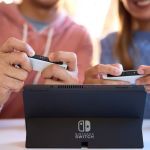
Nintendo revealed a new model of the Switch this week that adds an OLED screen, enhanced speakers, and a much-improved kickstand. One thing it seems the OLED Switch won’t bring, however, is a fix for the Joy-Con drift issues that have plagued Switch owners for years — and frustratingly, Nintendo won’t even confirm that it won’t. A variety of publications including The Verge tried to ask the question, but Nintendo won’t tackle it head-on, despite other helpful answers like how the new Switch won’t have a new CPU.
Switch owners have been reporting Joy-Con drift problems for years, and the problem is bad enough that it’s the subject of numerous lawsuits — though Nintendo will unofficially fix controllers experiencing Joy-Con drift for free, even if you’re out of warranty. One of our top requests for a revised Switch was a fix for the drift problems, and we hoped that a Switch revision would have been the moment Nintendo finally addressed this major issue. But it seems likely that Nintendo did not take the opportunity to do so.
In a statement Nintendo provided to Wired, Polygon, GameSpot and The Verge, the company said that the “Joy-Con controller configuration and functionality did not change with Nintendo Switch (OLED model).” But we didn’t ask about the “configuration” or “functionality,” as it was pretty clear from Nintendo’s announcement that the controllers would be the same. We asked about drift, which is a reliability issue. And when we asked the question again in an even clearer fashion, we were referred to the same statement.
That seems to suggest there aren’t any changes. An FAQ on the company’s UK website is even more explicit: “The Joy-Con controllers included with Nintendo Switch (OLED model) are the same as the controllers currently available.”
Nintendo’s statement does acknowledge that there are problems with Joy-Con controllers — “We are aware of reports that some Joy-Con controllers have not responded correctly,” Nintendo said — but merely suggested that customers visit its support site to deal with any issues. That language isn’t new; Nintendo issued a very similar statement nearly two years ago after Vice published an internal Nintendo memo instructing customer service reps to fix Joy-Con drift issues for free.
And Nintendo president Shuntaro Furukawa said that “we apologize for any inconvenience experienced by consumers” because of Joy-Con problems in an investor Q&A last year, but added that “I have no information to share about any specific actions we have taken” to fix issues, suggesting his hands were tied because of a class-action lawsuit in the US.
Until somebody can open up a set of Joy-Cons included with the new Switch, we won’t know for sure that there aren’t any unannounced fixes for the drift issues. But based on what Nintendo has said, I wouldn’t hold your breath.
While the OLED Switch may not have been the “Pro” upgrade we were hoping for, the improvements still make a big difference, according to my colleague Dieter Bohn, who got to try out the new Switch. But if you decide to pick up the $350 console when it launches October 8th, you might want to mentally prepare for the possibility that your new Joy-Cons might end up with the drift issue someday.
Here’s Nintendo’s full statement on the matter:
The Joy-Con controller configuration and functionality did not change with Nintendo Switch (OLED model). The configuration and functionally is the same as that of the Joy-con controllers for the Nintendo Switch console. At Nintendo, we take great pride in creating quality products and we are continuously making improvements to them. We are aware of reports that some Joy-Con controllers have not responded correctly. We want our consumers to have fun with Nintendo Switch, and if anything falls short of this goal we always encourage them to visit http://support.nintendo.com so we can help.
The post Nintendo refuses to say if the OLED Switch fixes Joy-Con drift, Jay Peters appeared first on NEWDAWN Blog.
Kickstart your weekend with this week’s best tech deals, Brandon Widder
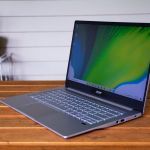
The weekend has arrived, bringing with it an assortment of great discounts on everything from student-centric laptops to headphones to some games that launched as recently as this week. We’ve rounded up many of the highlights below, and if you’re looking for the best of the best and not just what’s currently on sale, we’ve also updated our comprehensive guides to the best streaming devices and best gaming laptops, both of which offer a host of entertainment options for looking to escape the summer heat.
You don’t necessarily need to opt for a Google Nest Wifi system or a similar mesh network in order to boost your home’s Wi-Fi network — sometimes a simply Wi-Fi extender like the TP-Link AC750 will do. If you have a compatible router, the dual-band device will help boost its signal (not increase its speed), helping to alleviate dead zones in your home via a wired or wireless connection. Right now, you can pick TP-Link’s compact extender at Amazon for $20, a $15 discount and its lowest price to date.

The AC750 is an affordable way to increase the coverage of your home Wi-Fi network and improve its reliability. The dual-band extender is easy to set up and use, and features a built-in ethernet port if you prefer a wired connection over Wi-Fi.
$20
at Amazon
The Monster Hunter franchise has seen resurgent in the West in recent years thanks to blockbuster hits like Monster Hunter World and Monster Hunter Rise. However, the latest Nintendo Switch spin-off, Monster Hunter Stories 2: Wings of Ruin, is less about slaying monsters as it is catching them. The turn-based title is vibrant and a bit cliche, but if you’re looking for a MonHun game with a lighter tone and tried-and-true JRPG mechanics, Wings of Ruin is already on sale at Amazon for $50, nearly 20 percent of the list price.

Monster Hunter Stories 2: Wings of Ruin
$50 $60 17% offCapcom’s Monster Hunter Stories 2: Wings of Ruin might not be the monster-slaying title Western fans have become accustomed to, but it’s a solid JRPG with colorful characters and approachable, turn-based combat.
$50
at Amazon
If you’re a PC gamer who wants to make the most of titles like Fortnite and Apex Legends, a competent gaming mouse is a must-have accessory. Thankfully, the Logitech G502 Hero — the wired counterpart to our top pick for the best wireless gaming mouse — is an affordable way to go, with 11 customizable buttons, programmable lighting, and a flexible weight system that allows you to adjust the resistance to your liking on the fly. Typically on sale for around $50, Logitech’s G502 is currently available at Amazon for $38, the steepest price cut we’ve seen on the popular gaming mouse.

Logitech G502 Hero gaming mouse
$38 $80 53% offLogitech’s G502 Hero has most of the same features as our top pick for the best gaming mouse, the G502 Lightspeed — except it’s wired. If you’re okay with that, this is an excellent mouse that you can usually find for $50 or less.
$38
at Amazon
The Acer Swift 3 isn’t our No. 1 pick for the best student laptop, but it’s one of our go-to recommendations for college students given checks all the right boxes. It’s lightweight and performs well for the price, and at Costco, it’s available with 8GB of RAM, a 512GB SSD, and an AMD Ryzen 5 processor for $490. Like all configurations, Costco’s members-only variant also touts an integrated fingerprint reader, a healthy selection of ports, and a backlit keyboard for after-hours work. We admit that the Swift 3’s sturdy, aluminum build won’t win any design competitions, but it’s also a budget laptop that won’t break the bank, either. Read our review.

Acer’s Swift 3 laptop features a 14-inch 1080p IPS display, an AMD Ryzen 5 processor, 8GB of RAM, and a 512GB SSD. It also sports a fingerprint reader for easy sign-in and a backlit keyboard, making typing in low-light situations a breeze.
$490
at Costco (membership required)
Other deals of notePowerA’s Joy-Con Comfort Grips are a mere $5 at Amazon, their lowest price to date.Apple’s AirPods Max are more than $70 off at Amazon, bringing their final price down to $478. Read our review .Anker’s PowerPort Atom III Slim Wall Charger is $39 at Amazon, a sizable discount on a sleek, multi-port charger.Amazon is offering an Echo Dot (fourth-gen) and a four-pack of Tile Mate Bluetooth trackers for $80, more than 30 percent off the bundle’s typical retail price.
The post Kickstart your weekend with this week’s best tech deals, Brandon Widder appeared first on NEWDAWN Blog.
Meet the crew launching on Virgin Galactic’s 1st fully crewed flight Unity 22, ,
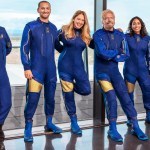
Virgin Galactic is counting down to launch its Unity 22 astronauts on the company’s first fully crewed suborbital spaceflight Sunday (July 11) and the mission’s crew took some time out from training to answer questions about what they expect from space.
The starring passenger is Virgin Galactic’s billionaire founder Richard Branson, but riding alongside will be Beth Moses, Virgin Galactic’s chief astronaut instructor; Colin Bennett, Virgin Galactic lead operations engineer; and Sirisha Bandla, the vice president of government affairs and research operations at the company. (Their spacecraft, VSS Unity, will be piloted by Dave Mackay and Michael Masucci, with C.J. Sturckow and Kelly Latimer piloting the carrier ship, VMS Eve.)
You can watch the launch live Sunday here and on Space.com’s homepage beginning at 9 a.m. EDT (1400 GMT).
Related: How to watch Virgin Galactic launch Richard Branson to space
More: How Virgin Galactic’s SpaceShipTwo works (infographic)
[image error]
Virgin Galactic founder Sir Richard Branson (third from right) will launch on the company’s first fully crewed flight on July 11, 2021 as part of a six-person crew. They are (from left): Pilot Dave Mackay; Colin Bennet, lead operations engineer; Beth Moses, chief astronaut instructor; Branson; Sirisha Bandla, vice president of government affairs and research operations; and pilot Michael Masucci. (Image credit: Virgin Galactic)Virgin Galactic posted a video Monday (July 5) on Twitter capturing the passenger crew’s reactions about getting to experience space, most of whom are getting to do so for the first time. (Technically speaking, the SpaceShipTwo vessel will fly below the internationally recognized Karman line at 62 miles or 100 kilometers, but above a 50-mile or 80-km boundary recognized by NASA, the Federal Aviation Administration and the U.S. military.)
Regardless of altitude, though, the crew said they were grateful of the chance to experience a spaceflight.
See more
“When I first heard I was getting this opportunity, it was just …” Bandla, pausing with a catch in her voice. “I think that probably captured it very well,” Bandla added of her emotion in answering the question about how she was feeling. “It was speechless.”
“When I was younger, I assumed that space was only available to a very select few,” Bennett said. (That said, non-employee pricing for a Virgin Galactic seat starts at a reported $250,000.) “I had no idea myself that I would ever be in a position to go to space myself, but here I am,” he added.
The crew also answered questions about the spaceflight experience in a series of short video posts on Twitter on Wednesday (July 7).
See more
Asked whether space is cold, Moses explained: “There is no air in space, but inside SpaceShipTwo it will be perfectly climate controlled. It will be absolutely perfectly comfortable at all times.” Moses, the only veteran astronaut among the passengers, got to experience the Unity cabin herself during a February 2019 flight. Of note, outside the spacecraft space can be hot or cold depending on the presence of our sun.
See more
Launches and landings are famous for inducing G-forces (or forces several times that of Earth’s gravity) on astronauts, but Bennett said he is prepared to handle the load because he has flown with high-performance jet pilots before. “I’m actually really looking forward to the high G part of the flight,” he said.
See more
“I’ve had dreams about the flight almost every night,” confided Bandla, when asked if she has been dreaming about what she will experience. “I’m one of those people who dream in vivid color every night, and ever since I got the news I’d go to space, I’ve been dreaming about it. I’m just so excited. It’s clearly there, in my mind.”
See more
Branson has been hoping to go to space since the Apollo 11 moon landing of 1969, and the 70-year-old discussed his plans for zero gravity during the approximately four minutes of weightlessness the crew will experience. “I’ll be looking back at our beautiful Earth, and taking it all in, and realizing that only 500 other people have done this,” he said.
Follow Elizabeth Howell on Twitter @howellspace. Follow us on Twitter @Spacedotcom and on Facebook.
The post Meet the crew launching on Virgin Galactic’s 1st fully crewed flight Unity 22, , appeared first on NEWDAWN Blog.
Richard Branson’s Virgin Galactic crew to sign flight log with special space pens, ,
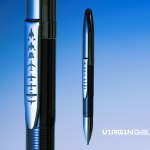
Fisher Space Pen, the company behind the pressurized writing instruments used by astronauts to take notes on the moon and check off checklists in orbit, is about to cross into another frontier: commercial spaceflight.
Fisher, which more than 50 years ago developed an ink cartridge that was capable of working without the need for gravity, has signed a deal with Virgin Galactic on the eve of the first fully-crewed flight of the SpaceShipTwo rocket plane. Richard Branson, Virgin Galactic’s billionaire founder, and his five “Unity 22” crewmates will use specially-adorned versions of Fisher’s Infinium space pen to sign their test flight log after launching to the edge of space on Sunday (July 11).
“They were seeking a pen appropriate for this particular event and obviously our name ‘Space Pen’ really fits well,” Joshua Skidmore, Fisher Space Pen’s director of sales and marketing, said in an interview with collectSPACE.com. “The six pens they are going to have for their crew to use will be space pens with the Virgin Galactic evolution of flight logo on them.”
Related: How to watch Virgin Galactic launch Richard Branson to space
More: How Virgin Galactic’s SpaceShipTwo works (infographic)
[image error]
Special Edition Apollo 11 50th Anniversary Matte Black Bullet Space Pen. $31.45 at Amazon View Deal
The black titanium nitride and chrome pens will be Infinium models, designed to write three times longer than an ordinary ballpoint pen. “In fact,” Fisher states on its website, “the Infinium Space Pen will write so long that the average user won’t run out of ink in their lifetime.” (The Virgin Galactic edition pens are not for sale.)
Virgin Galactic’s “DNA of Flight,” which also appears along the top of the VSS (Virgin SpaceShip) Unity and on the back of the crew’s Under Armour flight suits, symbolizes humanity’s journey to space through key aviation milestones. The design features icons representing Icarus (from Greek mythology), the Wright Flyer, Charles Lindbergh’s “Spirit of St. Louis” monoplane, Chuck Yeager’s Bell X-1 supersonic jet, Boeing’s 747 aircraft, NASA’s Apollo lunar module, the X Prize-winning SpaceShipOne and, at the top, SpaceShipTwo.
In Photos: Virgin Galactic’s Sleek Under Armour Spacesuits for Space Tourists
[image error]
Fisher Space Pen Bullet pens adorned with Virgin Galactic’s “DNA of Flight” will be gifted to Unity 22 spectators. (Image credit: Fisher Space Pen)“Each symbol represents a pivotal moment in the collective journey to creating the world’s first commercial spaceline,” Virgin Galactic said.
Fisher’s own history in that time line picks up with the lunar module. Its space pen was adopted by NASA for its moon missions in 1967 and by the Soviet Union’s space program (today, Russia’s Roscosmos state space corporation) for the early Soyuz flights two years later.
“Our pens have flown on every mission that has been piloted by astronauts or was flown with a crew since Apollo 7,” said Skidmore. “We also have a lot of pilots with commercial airlines who carry and use one.”
Virgin Galactic is the first company to openly acknowledge using the Fisher space pen as part of its spaceflight activities.
“This is the first non-NASA regulated flight that a space pen will be part of the event,” said Skidmore. He was not told if the pens will fly aboard VSS Unity or will be waiting for the crew after they land. In addition to Branson, the Unity 22 crew includes pilots Dave Mackay and Michael Masucci, as well as mission specialists Beth Moses, Colin Bennett and Sirisha Bandla.
“They had mentioned to us that there was not a need for a flight pen right now, but here’s the thing I can imagine: they are going up several hundred thousand feet and the only pen that will work in that environment is the space pen, so their pilots may already have our AG-7 [the same model pen used by NASA astronauts and Russian cosmonauts],” he said.
The Inifinum will not be the only Virgin Galactic-edition Fisher space pens present for the launch at Spaceport America in New Mexico.
“There are going to be roughly 550 people attending event and everybody is going to be receiving a swag bag,” Skidmore said. “Inside there, there will be a classic Bullet pen from Fisher Space Pen with the Virgin Galactic “DNA of Flight” logo on them as well.”
Follow collectSPACE.com on Facebook and on Twitter at @collectSPACE. Copyright 2021 collectSPACE.com. All rights reserved.
The post Richard Branson’s Virgin Galactic crew to sign flight log with special space pens, , appeared first on NEWDAWN Blog.
It’s been a long road to passenger spaceflight for Virgin Galactic and rival Blue Origin, ,
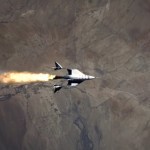
Richard Branson’s path to space has been quite a bit longer and more circuitous than he anticipated.
The billionaire founder of the Virgin Group is set to ride Sunday (July 11) on the fourth crewed spaceflight of Virgin Galactic’s SpaceShipTwo suborbital vehicle, which the company aims to have fully up and running early next year.
Branson’s participation will fulfill an oft-stated promise to be one of the first passengers that Virgin Galactic launches to the final frontier — a bucket-list box that was supposed to be ticked years ago.
Related:
How to watch Virgin Galactic launch Richard Branson to space
More:
How Virgin Galactic’s SpaceShipTwo works (infographic)
Branson founded Virgin Galactic in 2004 to build on the success of SpaceShipOne, a reusable three-person suborbital space plane built by the company Scaled Composites and financed by Paul Allen to win the $10 million Ansari X Prize for private spaceflight. Two years later, he told CNN that he expected the company to start carrying “ordinary people” to and from suborbital space in 2008. (Branson is far from ordinary by financial standards, but he’s not a professional astronaut, so he fits the bill.)
The target date kept getting pushed back, however, as Virgin Galactic dealt with various issues, including two fatal accidents. The first tragedy was a test-stand explosion at California’s Mojave Air and Space Port in July 2007, which killed three employees of Scaled Composites, the aerospace company that designed the two-pilot, six-passenger SpaceShipTwo.
The second occurred on Oct. 31, 2014, during a rocket-powered test flight of the first SpaceShipTwo vehicle, VSS Enterprise. (Branson will fly on the second, VSS Unity.) Enterprise broke apart in the skies above Mojave, killing co-pilot Michael Alsbury and seriously injuring pilot Peter Siebold.
An investigation determined that Alsbury unlocked Enterprise’s “feathering” re-entry system too early during the flight, leading to the winged vehicle’s demise. VSS Unity features design changes that will prevent such premature feather deployment from happening again, Virgin Galactic representatives have said.
The rival of Blue OriginVirgin Galactic’s chief competitor in the suborbital space tourism business, Jeff Bezos’ Blue Origin, also has a landmark flight coming up. Blue Origin is targeting July 20 for its first crewed mission — a suborbital jaunt that will send Bezos, his brother Mark, pioneering aviator Wally Funk and a still-mysterious auction winner aloft in the company’s New Shepard vehicle. (Blue Origin has not yet revealed the identity of the auction winner, who paid $28 million for his or her seat.)
Blue Origin has not suffered any fatal accidents, but its march to crewed flight has still taken two decades; Bezos founded the spaceflight company in 2000.
This very brief history lesson serves to reinforce a point that Branson himself made just the other day. “Space is very difficult,” he told National Public Radio’s Leila Fadel, during an interview that aired Wednesday (July 7). “Rocket science is very difficult.”
That’s especially true with human spaceflight, a field in which the smallest mistake or oversight can have catastrophic consequences, both for the people aboard the spacecraft and the company operating it.
This simple but important truth — spaceflight is hard — may get lost in the tumult of commentary that’s already piling up in advance of the Branson and Bezos flights. Some of the think pieces will run too hot, proclaiming the definitive dawn of a new commercial space age. Others will run too cold, labeling SpaceShipTwo and New Shepard mere toys compared with orbital craft such as SpaceX’s Crew Dragon capsule, which has already carried astronauts to the International Space Station three separate times.
An exciting, but uncertain, future[image error]
Virgin Galactic’s VSS Unity glides home after its second supersonic flight during test flights. (Image credit: Virgin Galactic)But it’s unclear what our current moment actually represents, and we won’t actually know until a fair few smoke-clearing years have passed.
It’s possible, for example, that the market for suborbital space tourism won’t be large enough to support the activities of either SpaceShipTwo or New Shepard over the long haul. But it’s also possible that their ticket prices will fall fast enough to keep the customers flooding in indefinitely, the future that both companies predict. (The most recently stated price for a seat aboard SpaceShipTwo was $250,000. Blue Origin has not yet revealed its standard ticket price, but it’s expected to be in the low six figures as well.)
The flights of Branson and Bezos, in short, are a window into a future we can’t yet see. You may have strong opinions about that future, about how the space tourism business, and commercial spaceflight more generally, will or should develop. And that’s fine. But it’s also fine to just sit by the window and wait, a cold drink in hand, happy that the drapes are being pulled after all these years.
Mike Wall is the author of “ Out There ” (Grand Central Publishing, 2018; illustrated by Karl Tate), a book about the search for alien life. Follow him on Twitter @michaeldwall. Follow us on Twitter @Spacedotcom or Facebook.
The post It’s been a long road to passenger spaceflight for Virgin Galactic and rival Blue Origin, , appeared first on NEWDAWN Blog.
Stephen Colbert will host Virgin Galactic’s SpaceShipTwo Unity launch on Sunday, ,
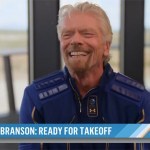
Richard Branson’s spaceflight is shaping up to be quite a star-studded affair.
The billionaire entrepreneur is scheduled to fly to suborbital space aboard Virgin Galactic’s VSS Unity SpaceShipTwo vehicle on Sunday (July 11). You can watch webcast coverage of the test mission here at Space.com courtesy of Virgin Galactic or directly via the company, beginning at 9 a.m. EDT (1300 GMT).
And you should watch, even if you’re not a big space fan, because the webcast will be hosted by Stephen Colbert.
Colbert came into the duties in a somewhat slapdash fashion. On Thursday (July 8), he tweeted congratulations to Branson and joked that his invitation to the big event must have gone straight to his spam folder. Branson replied with a livestream-hosting offer, and Colbert responded, “I’m in! BLAST OFF!”
Related: How to watch Virgin Galactic launch Richard Branson to space
See more
Colbert will be joined by the singer Khalid, who will premiere a song during the webcast; Canadian astronaut Chris Hadfield; and science communicator Kellie Gerardi, Virgin Galactic said via Twitter on Friday (July 9).
Sunday’s mission, which departs from Spaceport America in New Mexico, will be Unity’s fourth test flight to suborbital space. The other three occurred in December 2018, February 2019 and May of this year.
The six-passenger, two-pilot Unity takes off under the wings of a carrier aircraft known as VMS Eve. At an altitude of about 50,000 feet (15,000 meters), Eve drops Unity, which then fires up its onboard rocket motor and powers itself to suborbital space.
Unity is in the final stages of its test-flight program. If all goes well with Sunday’s flight and a few more in the fall, the spaceliner will be clear to begin commercial operations early next year, Virgin Galactic representatives have said.
Virgin Galactic’s chief competitor in the suborbital space tourism industry, Jeff Bezos’ Blue Origin, is gearing up for a big flight of its own this month. Bezos and three other people, including pioneering aviator Wally Funk, are scheduled to launch July 20 on the first crewed flight of Blue Origin’s New Shepard suborbital vehicle. No word yet on who will host that webcast.
Mike Wall is the author of “ Out There ” (Grand Central Publishing, 2018; illustrated by Karl Tate), a book about the search for alien life. Follow him on Twitter @michaeldwall. Follow us on Twitter @Spacedotcom or Facebook.
Join our Space Forums to keep talking space on the latest missions, night sky and more! And if you have a news tip, correction or comment, let us know at: community@space.com.
The post Stephen Colbert will host Virgin Galactic’s SpaceShipTwo Unity launch on Sunday, , appeared first on NEWDAWN Blog.
July 9, 2021
June 2021 smashed heat records in North America, ,

If the melting power cables in Portland, Oregon, weren’t enough of an indication, new satellite data confirms what many sweat-drenched Americans could have guessed: June 2021 was the single hottest June on record in North America.
The new data comes courtesy of the European Union’s Copernicus program, which produced climate measurements from billions of observations taken by satellite, aircraft and weather stations around the globe. According to the program’s new June 2021 report, last month was also the fourth-hottest June recorded worldwide and the second-warmest June recorded in Europe.
While human-induced climate change has been steadily bumping up average summer temperatures year after year (2020 tied 2016 for the planet’s hottest year on record, Live Science previously reported), a weather anomaly also contributed to the broiling temperatures in North America. The month saw record heat waves blast the Pacific Northwest and western Canada, with stagnant air bearing down on densely populated cities, like Seattle and Portland, for several days in a row. The culprit was a dangerous weather phenomenon called an omega block, which is essentially a dome of hot air trapped in place by atmospheric currents.
Related: 10 Steamy signs that climate change is speeding up
On June 28, Seattle saw its hottest day ever — a scorching 108 degrees Fahrenheit (42 degrees Celsius), or roughly 34 F (19 C) above the normal highs this time of year, according to The Washington Post. Not to be snubbed by American exceptionalism, Canada recorded national all-time high-temperature records three days in a row, culminating with a 121 F (49 C) day in British Columbia on June 29.
RELATED CONTENT
Images of melt: Earth’s vanishing ice
The reality of climate change: 10 myths busted
These records are not surprising, however; scientists have long predicted that global warming will result in ever-rising temperatures around the world. But the extreme June heat waves shed light on a new concern: The high-temperature records set in North America didn’t just surpass the old records; they utterly smashed them. During the heat waves, several cities in the U.S. and Canada saw temperatures rise more than 7 F (4 C) above previous records, Peter Stott, a climatologist at the U.K. Met Office, told the BBC — a far larger temperature increase than expected.
The data is “telling us that changes in average climate are leading to rapid escalation not just of extreme temperatures, but of extraordinarily extreme temperatures,” Stott said.
Welcome to another Hot Climate Summer.
Originally published on Live Science.
Join our Space Forums to keep talking space on the latest missions, night sky and more! And if you have a news tip, correction or comment, let us know at: community@space.com.
The post June 2021 smashed heat records in North America, , appeared first on NEWDAWN Blog.
Samsung quietly launched its free TV service on the web, Catie Keck
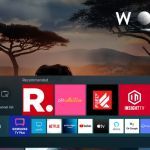
Samsung recently launched a web version of its free and ad-supported Smart TV Plus streaming service for live and linear programming as well as added casting support for Chromecast devices.
The streaming product, which was previously limited to Samsung TV and mobile devices, launched as a web service in the second quarter, Protocol reported Friday. It’s a curious new player in the streaming wars and launched with seemingly little fanfare, but the rollout makes an app that was previously limited to Samsung users now widely available to just about anyone.
Samsung did not have immediate comment about the launch when reached on Friday. However, a spokesperson confirmed the launch of the web version of the service to Protocol.
Samsung TV Plus has been around for years — it’s been available on Samsung smart TVs since 2016 — but the rollout to additional devices outside of the streaming ecosystem places it more directly in competition with ad-supported streaming services like Peacock, the Roku Channel, or any number of linear-programming freebies like Pluto TV or Plex.
While it’s unclear why the company seems to have decided to soft launch the web version of its streaming service now, Samsung appears to be exploring ways to bring TV Plus to a larger audience. Choice is always great and you can’t beat the price of free (particularly if you can stand to sit through ads), but if Samsung’s ambitions are to dominate the linear streaming space, it’s a bit late to the party.
The post Samsung quietly launched its free TV service on the web, Catie Keck appeared first on NEWDAWN Blog.



